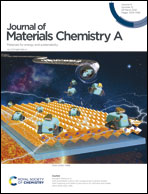Methylamine-assisted secondary grain growth for CH3NH3PbI3 perovskite films with large grains and a highly preferred orientation†
Abstract
Organic–inorganic hybrid perovskite materials have attracted significant attention due to their intriguing optical and electrical properties. However, it is a challenge to grow a perovskite thin film with controlled crystallinity and large-sized grains by a simple solution process, which is important for highly efficient and stable perovskite solar cells. Herein, a methylamine-assisted secondary grain growth approach is developed for post-annealing of a methyl ammonium lead iodide (MAPbI3) perovskite film in a controlled methylamine (MA0) atmosphere, leading to the formation of a full-coverage and highly oriented perovskite film with large grain sizes up to tens of microns. The resultant perovskite film shows low trap density, strong photoluminescence, and a prolonged decay lifetime. The perovskite photovoltaic device shows an enhanced power conversion efficiency (PCE) of 20.81% with good environmental stability. The method reported here provides a promising and facile route to fabricate high-quality MAPbI3 perovskite films for efficient optoelectronic devices.



 Please wait while we load your content...
Please wait while we load your content...